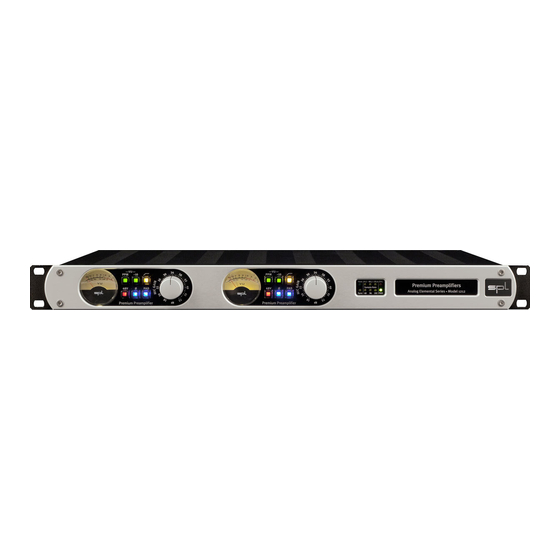
Table of Contents
Advertisement
Advertisement
Table of Contents

Summarization of Contents
Introduction to Analog Elemental Series
The Analog Elements
Describes the overall concept and philosophy behind the series.
The Next Generation Signal Processors
Details advancements in processor development.
Concept and Categories of the Analog Elemental Series
Explains the modular structure and product types.
Dual-Channel Preamplifiers
Describes preamp configurations and models.
Channel Strips
Describes channel strip configurations and models.
Premium or Preference Preamp & Dual Band De-Esser
Details specific module combinations.
Premium or Preference Preamp & TwinTube
Details specific module combinations.
Processing Units
Discusses standalone processing modules.
Dual-Band De-Esser & TwinTube
Details specific module combinations.
Dual-Band De-Esser & DynaMaxx
Details specific module combinations.
TwinTube Processors
Describes standalone TwinTube unit.
Transient Designer & TwinTube
Details specific module combinations.
Optional Features
Lists optional hardware upgrades.
Information on Transformers
Explains the sonic benefits of transformers.
Common Technical Specifications
Lists general technical parameters.
Dimensions and Weight
Provides physical data for the units.
Rear Panel Wiring and Connections
Rear Panel | Wiring Diagram
Illustrates signal flow and connections.
Rear Panel | Versions
Describes different rear panel configurations.
Rear Panel | Connections and Switches
Details input/output and operational switches.
Signal Connections
General advice on connecting cables.
Input and Output Electronics
Explains the internal circuitry.
XLR sockets
Details on XLR connector pinouts.
Balanced connections
Explanation of balanced audio signals.
Unbalanced connections
Explanation of unbalanced audio signals.
Power connection and fuse
How to connect power and replace fuses.
Voltage Selector
Setting the correct input voltage.
Power switch
Operation of the main power switch.
GND Lift
Switch for hum reduction.
Channel Strip Switch (Ch. 1 OUT = Ch.2 IN)
Internal module routing switch.
Premium Mic Pre Module
Introduction
Overview of the Premium Mic Pre.
Features
Lists key attributes and capabilities.
Control Elements
Introduces front panel controls for the module.
Mic Gain
Adjusting the preamplification level.
About Leveling
Guidance on setting optimal input levels.
VU Meter
Description of the output level meter.
PPM
Peak Program Meter mode selection.
-10
Sensitivity adjustment for the meter.
48 V Phantom Power Supply
Details on powering microphones.
Pad
Input signal attenuation function.
Phase Reverse
Polarity inversion switch.
High-Pass Filter
Low-frequency noise reduction.
Technology
Technical design and circuitry explanation.
Triple Stage Preamp
Explanation of the preamp stages.
Stage 1 - The Input Transformer
Details on the input transformer.
Stage 2 - The Discrete Differential Amplifier
Explanation of the differential amp stage.
Stage 3 – The Instrumentation Amplifier
Details on the instrumentation amplifier.
Foil and Styroflex Capacitors
Information on component selection.
Output Stages
Explanation of the output stage design.
Technical Specifications
Detailed technical data.
Block Diagram
Schematic of the module's signal path.
Preference Mic Pre Module
Introduction
Overview of the Preference Mic Pre.
Main Features
Lists key attributes and capabilities.
Control Elements
Introduces front panel controls for the module.
Mic Gain
Adjusting the preamplification level.
About Leveling
Guidance on setting optimal input levels.
VU Meter
Description of the output level meter.
PPM
Peak Program Meter mode selection.
-10 dB
Sensitivity adjustment for the meter.
48 V Phantom Power Supply
Details on powering microphones.
Pad
Input signal attenuation function.
Phase Reverse
Polarity inversion switch.
High-Pass Filter
Low-frequency noise reduction.
Technology
Technical design and circuitry explanation.
SSM 2019
Details on the SSM 2019 integrated circuit.
Servo Drive Design
Explanation of the servo drive circuit.
Foil And Styroflex Capacitors
Information on component selection.
Output
Explanation of the output stage design.
Technical Specifications
Detailed technical data.
Block Diagram
Schematic of the module's signal path.
Dual-Band De-Esser Module
Introduction
Overview of the Dual-Band De-Esser.
The Dual-Band De-Esser
Focus on the dual-band processing concept.
Control Elements
Introduces front panel controls.
HI-Band On, Low-Band On
Controls for activating frequency bands.
Low S-Reduction
Adjusting sibilance in the lower band.
High S-Reduction
Adjusting sibilance in the upper band.
Male/Female
Adapting processing to voice type.
Signal-LED (SIG.)
Indicates presence of an input signal.
Technical Specifications
Detailed technical data.
Block Diagram
Schematic of the module's signal path.
DynaMaxx Compressor Module
Introduction
Overview of the DynaMaxx compressor.
Control Elements
Introduces front panel controls.
Compression
Adjusting compression intensity.
Make-Up Gain
Compensating for level reduction.
Gain Reduction LEDs
Visual indicator of gain reduction.
DE-COM. (De-Compression)
Expanding compressed signals.
FX Com. (Effect Compression)
Mode for creative, audible compression.
Lim. (Limiter)
Peak limiting function for headroom.
On
Device power activation.
Link
Stereo linking of two modules.
Signal-LED (SIG.)
Indicates presence of an input signal.
Technology
Technical design and automation explanation.
Why are conventional compressors unsatisfactory?
Discusses limitations of standard compressors.
Full-Band versus Multi-Band
Compares compression approaches.
Attack Time Automation
Explanation of dynamic attack time adjustment.
Release Time Automation
Explanation of dynamic release time adjustment.
Threshold And Ratio
How these are controlled.
Technical Specifications
Detailed technical data.
Block Diagramm
Schematic of the module's signal path.
Transient Designer Module
Introduction
Overview of the Transient Designer.
On
Device power activation.
Attack
Control for shaping transient attack.
Sustain
Control for shaping transient sustain.
Output Gain
Adjusting the output signal level.
Link Mode
Stereo linking of two modules.
Signal LED
Indicates presence of an input signal.
Applications
Use cases and practical examples.
Drums & Percussions
Specific application example.
Guitars
Specific application example.
Bass: Staccato vs. Legato
Specific application example.
Ambience
Specific application example.
Keyboards & Sampler
Specific application example.
Post Production
Specific application example.
Mastering
Specific application example.
Technical Specifications
Detailed technical data.
Block Diagram
Schematic of the module's signal path.
TwinTube Module
Introduction
Overview of the TwinTube module.
Control Elements
Introduces front panel controls.
HAR. ON/SAT. ON
Switches for activating effects.
HARMONICS Switch
Selects harmonics frequency range.
SATURATION Control
Adjusts tube saturation level.
Signal LED
Indicates presence of an input signal.
Applications
Use cases and practical examples.
Vocals
Specific application example.
Acoustic Guitars
Specific application example.
Measurements
Presents technical measurement data.
Technical Specifications
Detailed technical data.
Block Diagram
Schematic of the module's signal path.















Need help?
Do you have a question about the DynaMaxx and is the answer not in the manual?
Questions and answers